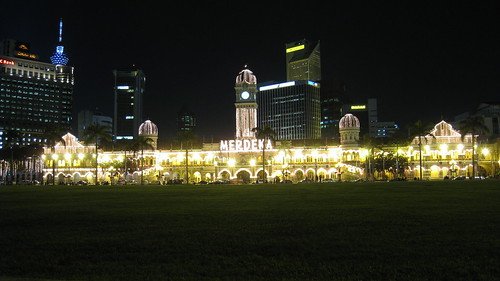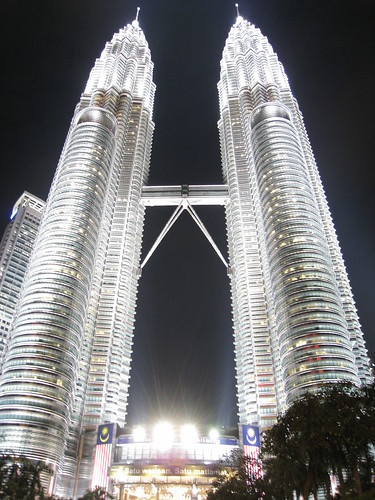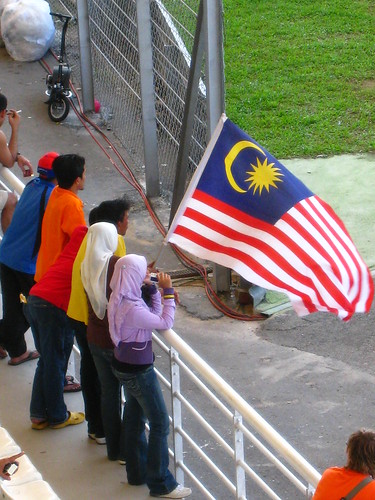 Kuala Lumpur is a cross between Singapore and Melaka. It has the infrastructure of Singapore but is slightly mental. For instance, they have traffic lights but they are rarely obeyed. I was in Medaka square crossing the road at a set of lights, the green man started walking (he is animated in Malaysia) and the countdown clock started. I crossed only to have a motorcycle flash passed infront of me, a car carried on behind me and another car had to do an emergency stop next to me (talk about skid marks). I try to follow the policy of crossing when a local does and putting them between me and the oncoming traffic.
Kuala Lumpur is a cross between Singapore and Melaka. It has the infrastructure of Singapore but is slightly mental. For instance, they have traffic lights but they are rarely obeyed. I was in Medaka square crossing the road at a set of lights, the green man started walking (he is animated in Malaysia) and the countdown clock started. I crossed only to have a motorcycle flash passed infront of me, a car carried on behind me and another car had to do an emergency stop next to me (talk about skid marks). I try to follow the policy of crossing when a local does and putting them between me and the oncoming traffic. KL is a raw version of Singapore. The Petronas Towers are more dazzling than anything Singapore has to offer. Yet there are so many litter strewn alleys that you pass. There are whole streets of ruined buildings. The most disturbing scene I've yet seen on my travels was a man lying in the gutter outside the Times Square Mall. He was spread eagled on the floor with an open wound on his leg. There was a steady stream of people passing him on both sides of the packed pavement. I'm not suggesting that Malaysians are any less caring than other nations, I'm sure such a scene could be witnessed in London, Paris or New York. It just seems that the gap between rich and poor is greater here and more distinct.
KL is a raw version of Singapore. The Petronas Towers are more dazzling than anything Singapore has to offer. Yet there are so many litter strewn alleys that you pass. There are whole streets of ruined buildings. The most disturbing scene I've yet seen on my travels was a man lying in the gutter outside the Times Square Mall. He was spread eagled on the floor with an open wound on his leg. There was a steady stream of people passing him on both sides of the packed pavement. I'm not suggesting that Malaysians are any less caring than other nations, I'm sure such a scene could be witnessed in London, Paris or New York. It just seems that the gap between rich and poor is greater here and more distinct.
 There is quite a bit to see in KL. The Petronas Towers are a must. The visit up to sky bridge is free (you just have to queue up in the morning for a ticket). It isn't the most exciting. partly due to Petronas using it as an opportunity for a company presentation, and partly due to you not being able to see the Petronas Towers. The view from the KL Tower is better, because you are higher up and you get to see the Petronas Towers. Merdeka square is pretty, and it is a good time to visit as Malaysia is celebrating its 50th year of independence, so there are plenty of flags. The Batu Caves are spectacular. They are Hindu temples outside of KL. It takes just over half an hour to get there by bus. When you get there you have to climb over 250 steps to get to the main temple. The main temple is full of monkeys. These monkeys are trained in the art of stealing food from tourists and intimidating small children. The drive on the bus is worth the trip in itself. In KL the bus conductors hawk for business. They hang out the side of the bus as you are driving along yelling out their destinations to anyone walking along the pavement. It gets even more intense at proper bus stops where they compete against one another for business.
There is quite a bit to see in KL. The Petronas Towers are a must. The visit up to sky bridge is free (you just have to queue up in the morning for a ticket). It isn't the most exciting. partly due to Petronas using it as an opportunity for a company presentation, and partly due to you not being able to see the Petronas Towers. The view from the KL Tower is better, because you are higher up and you get to see the Petronas Towers. Merdeka square is pretty, and it is a good time to visit as Malaysia is celebrating its 50th year of independence, so there are plenty of flags. The Batu Caves are spectacular. They are Hindu temples outside of KL. It takes just over half an hour to get there by bus. When you get there you have to climb over 250 steps to get to the main temple. The main temple is full of monkeys. These monkeys are trained in the art of stealing food from tourists and intimidating small children. The drive on the bus is worth the trip in itself. In KL the bus conductors hawk for business. They hang out the side of the bus as you are driving along yelling out their destinations to anyone walking along the pavement. It gets even more intense at proper bus stops where they compete against one another for business. I haven't faced a great deal of hawking since arriving in South East Asia, apart from the restaurateurs in Boat Quay Singapore. In China Town KL there is a giant street market. It is hot sweaty and claustrophobic. It is a hawkers paradise. They did their best to tempt me into their stall and at times would grab me by the arm. I met all attempts with a smile and shake of the head. I find that the best way to deal with hawkers is to smile and say no thankyou. It doesn't require you getting angry or frustrated. However, Bukit Bintang can try anyone's patience. It is a popular street in the Golden Triangle, close to where I was staying. During the day it is busy. In the evening it gets busier and the massage shops open. They have hawkers sitting on the street outside their establishments. When you walk passed they jump out at you with laminated picture cards of the work they offer. I tried to meet all advances with a smile and polite no thankyou. It does get frustrating when you are trying to get somewhere and they keep jumping out at you, especially when you have already rejected 5 and the hawker can see this but still believes that they will somehow persuade you.
I stayed at Pondok Lodge in KL. It is in the Golden Triangle just off of Bukit Bintang and within walking distance of the Petronas Towers. I had a bed for RM25.00 which included breakfast. Breakfast was not your typical hostel affair where blood thirsty backpackers compete to grab what they can. At Pondok Lodge they had a guy serve you, admittedly it was just 2 pieces of toast, a banana, a piece of fruit loaf and a cup of tea, but it was still nice. I ended up in twin room with a Pakistani guy who had been living there for a few months. The room was fine apart from the air conditioning being shared between two rooms. There was a hole in the wall between the two rooms and the air conditioning was cunningly placed in the middle. The controls were in the other room and we had the remote in our room. This meant that during the night there was a fight between both parties to keep it on or to keep it off. Pondok Lodge is above a number of bars, so it can be a bit noisy but I never found it a problem. They also have a rooftop terrace which is a great place to escape the hustle and bustle of KL and hopefully grab a breeze to stop sweating for 5 minutes.

Defining who a local is in KL and Malaysia isn't quite straight forward. There are 4 distinct groups of locals. There are the Orangi Asli the native people who live in tribes (more to come on them in the Cameron Highlands). There are the Malays, the Chinese and the Tamil Indians. The Malays are Muslim. I like all the colourful headscarfs. I can't remember which politician said that they found headscarfs 'confronting' but it struck me as a daft comment at the time and after is even more ridiculous when you travel in Malaysia. You are constantly greeted by smiling headscarf clad faces. The Chinese have lived in Malaysia prior to European involvement in the region. They moved to the Malay peninsula as traders. The Indians have a similar history, however, the greater part of the Tamil Indians were brought in by the British either as slaves or as workers. The deal struck between the groups when Malaysia gained independence from Britain was that the Malays would have political power, the Chinese would continue to hold the economic power and the Indians were left to fill in the gaps. On the surface this form of multi-culturalism seems to work. However, the 3 groups maintain separate lives. They work together but they do not live together. In my time in Malaysia even the 3 races working together is somewhat unusual. Shops and restaurants are generally staffed by one race. The people who agitate most against the status-quo are the Tamil Indian community because they get the roughest deal out of all three. While I was at the A1GP in Sepang there was a big demonstration in KL at the Petronas Towers. Click here for a link to a BBC News article about the Indian Demonstration. The Malay constitution states that only a Muslim can be head of the government. There is also defacto discrimination with Malays being entitled to open shops in certain areas where Indians and Chinese cannot. In a recent law regarding foreign firms starting businesses in Malaysia the law stated that the foreign firm must employ at least one Malay (not one Malay, Chinese, or Indian). This is all the more interesting after you have visited the National Museum in KL. It has a special section on Merdeka, celebrating 50 years of independence from Britain (hence all the Malaysian flags in my photos). There is a video presentation when an old Malay man tells his grandson (Malay) and his two friends (a Chinese girl and an Indian boy) about the struggle for independence. He says how the three races now live side by side, equally, in a free democracy.
 Kuala Lumpur is a cross between Singapore and Melaka. It has the infrastructure of Singapore but is slightly mental. For instance, they have traffic lights but they are rarely obeyed. I was in Medaka square crossing the road at a set of lights, the green man started walking (he is animated in Malaysia) and the countdown clock started. I crossed only to have a motorcycle flash passed infront of me, a car carried on behind me and another car had to do an emergency stop next to me (talk about skid marks). I try to follow the policy of crossing when a local does and putting them between me and the oncoming traffic.
Kuala Lumpur is a cross between Singapore and Melaka. It has the infrastructure of Singapore but is slightly mental. For instance, they have traffic lights but they are rarely obeyed. I was in Medaka square crossing the road at a set of lights, the green man started walking (he is animated in Malaysia) and the countdown clock started. I crossed only to have a motorcycle flash passed infront of me, a car carried on behind me and another car had to do an emergency stop next to me (talk about skid marks). I try to follow the policy of crossing when a local does and putting them between me and the oncoming traffic. KL is a raw version of Singapore. The Petronas Towers are more dazzling than anything Singapore has to offer. Yet there are so many litter strewn alleys that you pass. There are whole streets of ruined buildings. The most disturbing scene I've yet seen on my travels was a man lying in the gutter outside the Times Square Mall. He was spread eagled on the floor with an open wound on his leg. There was a steady stream of people passing him on both sides of the packed pavement. I'm not suggesting that Malaysians are any less caring than other nations, I'm sure such a scene could be witnessed in London, Paris or New York. It just seems that the gap between rich and poor is greater here and more distinct.
KL is a raw version of Singapore. The Petronas Towers are more dazzling than anything Singapore has to offer. Yet there are so many litter strewn alleys that you pass. There are whole streets of ruined buildings. The most disturbing scene I've yet seen on my travels was a man lying in the gutter outside the Times Square Mall. He was spread eagled on the floor with an open wound on his leg. There was a steady stream of people passing him on both sides of the packed pavement. I'm not suggesting that Malaysians are any less caring than other nations, I'm sure such a scene could be witnessed in London, Paris or New York. It just seems that the gap between rich and poor is greater here and more distinct. There is quite a bit to see in KL. The Petronas Towers are a must. The visit up to sky bridge is free (you just have to queue up in the morning for a ticket). It isn't the most exciting. partly due to Petronas using it as an opportunity for a company presentation, and partly due to you not being able to see the Petronas Towers. The view from the KL Tower is better, because you are higher up and you get to see the Petronas Towers. Merdeka square is pretty, and it is a good time to visit as Malaysia is celebrating its 50th year of independence, so there are plenty of flags. The Batu Caves are spectacular. They are Hindu temples outside of KL. It takes just over half an hour to get there by bus. When you get there you have to climb over 250 steps to get to the main temple. The main temple is full of monkeys. These monkeys are trained in the art of stealing food from tourists and intimidating small children. The drive on the bus is worth the trip in itself. In KL the bus conductors hawk for business. They hang out the side of the bus as you are driving along yelling out their destinations to anyone walking along the pavement. It gets even more intense at proper bus stops where they compete against one another for business.
There is quite a bit to see in KL. The Petronas Towers are a must. The visit up to sky bridge is free (you just have to queue up in the morning for a ticket). It isn't the most exciting. partly due to Petronas using it as an opportunity for a company presentation, and partly due to you not being able to see the Petronas Towers. The view from the KL Tower is better, because you are higher up and you get to see the Petronas Towers. Merdeka square is pretty, and it is a good time to visit as Malaysia is celebrating its 50th year of independence, so there are plenty of flags. The Batu Caves are spectacular. They are Hindu temples outside of KL. It takes just over half an hour to get there by bus. When you get there you have to climb over 250 steps to get to the main temple. The main temple is full of monkeys. These monkeys are trained in the art of stealing food from tourists and intimidating small children. The drive on the bus is worth the trip in itself. In KL the bus conductors hawk for business. They hang out the side of the bus as you are driving along yelling out their destinations to anyone walking along the pavement. It gets even more intense at proper bus stops where they compete against one another for business. 
No comments:
Post a Comment